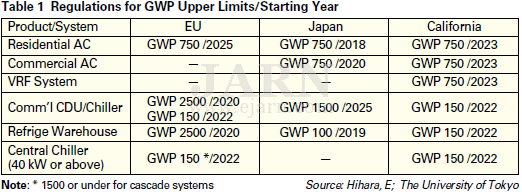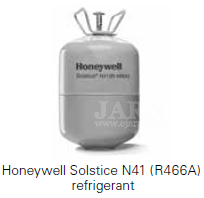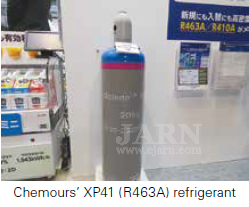Here, mid-and low-temperature equipment refers to equipment commonly called air conditioners for comfort cooling as well as refrigeration equipment for the purpose of cooling down to approximately –40℃.
R22 (HCFC) refrigerant is still used in mid-and low-temperature equipment for air conditioning, as well as R410A (HFC) more recently. R22 was also used for refrigeration applications, but R404A has now come to be broadly used instead. All of these refrigerants are fluorocarbon-based chemical substances. In contrast, the natural refrigerants of ammonia (R717), carbon dioxide (CO2), isobutane (R600a), and more recently propane (R290) have also come to be used, especially in refrigeration applications. These refrigerants are flammable gases (and in the case of ammonia, toxic), which carry high risks, and are subject to strict legislation by countries. Meanwhile, hydrochlorofluorocarbons (HCFCs) and hydrofluorocarbons (HFCs) have high global warming potential (GWP), and there are growing calls around the world to restrict their use for this reason.
Kigali Amendment
At the Meeting of the Parties to the Montreal Protocol held in Kigali, Rwanda, in October 2016, an amendment to the Montreal Protocol was adopted that obligates member nations to phase down their use of HFCs. Up to now, the Montreal Protocol has served as an international treaty prohibiting the use of sub-stances with ozone depletion potential (ODP), such as chlorofluorocarbons (CFCs), to protect the ozone layer. The amendment represents a breakthrough agreement to fight global warming that also includes reducing the use of greenhouse gases.
As a result, countries must now reduce their use of HFC refrigerants with high GWP. For example, developed countries are obligated to reduce their HFC production and consumption by 10% in 2019 compared with a baseline comprising their average consumption in the years 2011–2013 plus the HCFC baseline x 15%. This reduction climbs to 70% in 2029 and 85% in 2036. Every country will be forced to shift away from using high- GWP refrigerants or they will not be able to meet this obligation.
Table 1 shows the GWP upper limit by major product and system, as well as the starting year, in the European Union (EU), Japan, and California State in the United States.

Shift to Low-GWP Refrigerants
R410A (HFC) is the main air conditioner refrigerant in use today, but it has a high GWP of approximately 2,090. The HFC R32 (GWP: 675) has become widely used as a replacement for R410A. However, R32 is a mildly flammable gas (ASHRAE classification of A2), and carries significant safety risks when used in larger equipment, and particularly in applications such as supermarkets.
In terms of refrigeration refrigerants, excluding applications that use sub-stances like ammonia that require a certified technician to handle, equipment like small-and medium-sized display cases has shifted from using R22 (nonflammable HCFC) to R404A, but R404A’s high GWP of 3,922 poses a problem.
As JARN reported in the April 2019 issue (p. 4), several candidate refrigerants to replace the main-stream air conditioner refrigerant R410A were announced last year.
U.S. chemical manufacturer Chemours is promoting its XP41 (R463A) refrigerant in the Opteon series to replace R410A and R404A.
Honeywell (www.honeywell.com) is a Fortune 100 technology company that delivers industry specific solutions that include aerospace products and services; control technologies for buildings and industry; and performance materials globally. Our technologies help everything from aircraft, buildings, manufacturing plants, supply chains, and workers become more connected to make our world smarter, safer, and more sustainable. For more news and information on Honeywell, please visit www.honeywell.com/newsroom.
Rival Honeywell announced its Solstice N41 refrigerant (provisional number R466A) in June 2018. Honeywell had announced that R466A would be available in mid-2019, but it was recently reported that this has been pushed back to the end of 2019. Both of these refrigerants are hydrofluoroolefin (HFO) blends that are nonflammable and have low GWP.
Recent reports also state that in Europe, Honeywell announced the results of tests of another new refrigerant (HDR147) it has developed. Detailed information is not yet avail- able, but the new refrigerant is said to be nonflammable like R466A, have a low GWP of around 400, and offer similar performance to R410A.
Equipment Manufacturer Trends
Air conditioner and refrigeration (AC&R) equipment manufacturers are quickly coming up against the need to shift to low-GWP refrigerants. In Japan for example, R404A is becoming more expensive and difficult to obtain in 2019 as a result of the restriction on production volume. Manufacturers of equipment such as reach-in display cases are gradually shifting to R448A from R404A. R448A is a nonflammable blend of five refrigerants (R32, R125, R134a, R1234yf, R1234ze) with a GWP of 1,387. If R404A has a coefficient of performance (COP) of 100, R448A’s would be 110, meaning it offers good energy efficiency and therefore better running cost.
Manufacturers including Toshiba Carrier and Hitachi have released products that use R448A refrigerant. Mitsubishi Electric is using Chemours’ XP41 (R463A) in the Opteon series in its low-temperature equipment that has used R410A, some of which it displayed at FOOMA Japan 2019 held in Tokyo in July as reported in the August 2019 issue of JARN.
R463A is a blend of the five refrigerants of R32, R125, R134a, R1234yf, and R744 (CO2) with a GWP of 1,494. It is nonflammable and offers high energy density similar to R410A. If R404A and R448A have a refrigerant charge of 100, then R463A only needs a charge of 81, which also installation costs. In terms of energy efficiency, if R404A has a COP of 100, R463A’s would be 112, meaning it also offers running cost benefits according to Mitsubishi Electric. makes it an economic choice in terms of
Mitsubishi Electric will continue to mainly offer products that use R410A for the time being, but has plans to develop products that can replace either R410A or R463A products, in other words, dual use products.
Other Manufacturer Trends
Carrier announced that it would use R454B refrigerant from Chemours as a low-GWP alternative to R410A in ducted residential and light commercial air conditioners sold in the United States (p. 6 in April 2019 issue of JARN). According to its announcement, Carrier plans to change the commercial name of Opteon XL41, Chemours’ mildly flammable refrigerant, to Puron Advance when it uses it.
Carrier also announced that it would use a low-GWP refrigerant in chillers for the European market that are produced at its factory in Montluel, France.
Carrier has selected R1234ze (HFO) refrigerant to replace R134a (HFC) in its screw chillers and heat pumps. According to the Fifth Assessment Report of the Intergovernmental Panel on Climate Change (IPCC), R1234ze(E) has a GWP of less than 1, and is therefore not impacted by the EU’s F-gas Regulation and the restrictions of the Kigali Amendment to the Montreal Protocol.
Carrier has chosen the HFO R1233zd(E) as its preferred long-term refrigerant for its centrifugal chillers. It has a GWP of less than 1. Carrier’s AquaEdge 19DV model is an example of a successful product using this refrigerant, with sales now in the hundreds of units.
Mitsubishi Heavy Industries Thermal Systems (MHI) in Japan is also using R1233zd(E) in its centrifugal chillers.
Daikin is one of the world’s largest AC&R equipment manufacturers, but is not showing major signs of developing or manufacturing new refrigerants. However, Daikin adopted R32 as a replacement for R410A ahead of other companies, and is a Top Runner (efficiency leader in Japan) in small-capacity air conditioners. It offers free access to its patents for mildly flammable R32 and has been hugely successful in getting R32 adopted in Japan as well as other parts of Asia and Europe.
Daikin is also advocating the use of nonflammable R407H refrigerant. The company has increased its refrigerant technology staff and seems to be starting to focus on new refrigerant development. It may offer new refrigerants with GWP of less than 10 in the marketplace in the near future. Leading Chinese air conditioner manufacturer Midea has released air conditioners using R452B in the U.S. market, while Johnson Controls announced a chiller that uses R454B.
Midea recently concluded an agreement with Honeywell, with Midea reportedly set to use Honeywell’s nonflammable, low-GWP new refrigerant R466A in its variable refrigerant flow (VRF) systems and chillers.
Toshiba Carrier also has an alliance with Midea and announced research findings in January 2019 that its tests of R466A found the refrigerant ‘promising.’
What will be the big next-generation refrigerant?
Many types of refrigerants have been announced in the marketplace, but which ones will become the main ones in the near future?
Research is also being performed related to the safe use of other non-chemical refrigerants, for example natural flammable refrigerants.
Currently in Japan, mildly flammable R32 has become the mainstream refrigerant for residential and commercial air conditioners, and R32 air conditioners are becoming widely used in Europe as well. Nevertheless, R32 has a GWP of 675 and is mildly flammable. In the future, refrigerants with GWP lower than, say, 150 will need to be developed.
| 出典: | eJARN |

